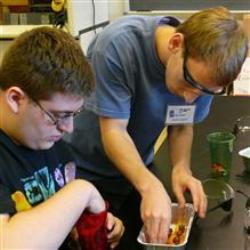Jul 20 2013
Inside an engineering lab, 16 teenagers sift studiously through bags of their favorite candies.
 For their chocolate composite, Kenny Gahler (left) of Boyertown High School and Eric Scott of Southern Lehigh High School chose Whoppers for impact resistance and Gummy Worms for their stretching ability.
For their chocolate composite, Kenny Gahler (left) of Boyertown High School and Eric Scott of Southern Lehigh High School chose Whoppers for impact resistance and Gummy Worms for their stretching ability.
In groups of twos and threes, they examine chocolaty Raisinettes, malted milk Whoppers, licorice Twizzlers, rubbery Gummy Worms and Gummy Bears, and chewy Mike and Ike’s.
The teens are not interested in taste or texture but in bonding and ductility. Their goal, at the tenth Lehigh Valley ASM Materials Camp—hosted each year by Lehigh’s department of materials science and engineering and the Lehigh Valley chapter of ASM International—is to determine which two candy types, when combined with chocolate, will form the strongest composite.
After choosing their candy pairs, the groups set them in aluminum bread pans. Melted chocolate will be poured into each pan, and the mixture frozen overnight. The next morning, each slab of hardened chocolate will be subjected to a Charpy impact test to determine which composite best absorbs the energy from a hammer blow.
Abigail Lawrence ’10, a graduate student in materials science and one of the camp’s two lead instructors, tells the students that the arrangement of the candies on the bread pan can be crucial.
“There are different ways of arranging the candy pieces,” she says. “Some will make the bonding with the chocolate stronger, some will make it weaker.
“Think of the key words you’ve learned this week—ductile and brittle.”
After completing their projects, the groups defend their decisions to Lawrence and fellow grad student Mike Kracum ’11, the camp’s other lead instructor.
Kenny Gahler and Eric Scott decide on alternating rows of Gummy Worms and Whoppers. The Whoppers’ chocolate coating, they say, will bond with the melted chocolate and provide initial resistance to the Charpy’s swinging hammer. If that fails, the Worms will stretch and absorb the force.
Two tables away, Marlee Senderowitz, Kelly Hogan and Juliana Hong opt for a row of Gummy Worms overlaid with a row of Twizzlers in a crisscross pattern. They leave small gaps between the candies to allow the melted chocolate to seep through.
On top of the crisscrossed candies, the girls place a braided pair of Gummy Worms to absorb the initial impact of the Charpy hammer.
“The young teaching the young”
The Lehigh Valley ASM Materials Camp was started in 2004 by Lehigh’s department of materials science and engineering and the Lehigh Valley chapter of ASM International, a professional society. Several local companies, including Carpenter Technologies of Reading, Pa., have sponsored the camp.
The camp is free. It lasts one week each July and enrolls 16 high school students from the Lehigh Valley and the Reading area. Its purpose is to inspire young people to pursue careers in engineering and, especially, in materials science and engineering.
“I didn’t know much about materials science before,” said Nick Mazzella of Freedom High School in Bethlehem. “This has been a good experience.”
Besides fabricating chocolate composites, the students learn about polymers, biomaterials, glasses, metals, and materials for energy and sports. They tour Lehigh’s welding and microscopy labs, and the ATLSS (Advanced Technology for Large Structural Systems) Center.
Lehigh’s is the first ASM Materials Camp to be taught by graduate students. The camp’s faculty adviser, Wojciech Misiolek, and two former instructors, Ryan Deacon ’01 ’07 Ph.D., and Clifford Prescott ’03 ’05 M.S., explained why in 2006 in the International Journal of Engineering Education.
“The concept behind this new format is simple—the young teaching the young,” they wrote. Teenagers relate better to slightly older students than to faculty members, they said, and graduate students learn how to teach and present engineering concepts.
Alumni also help teach the camp. Jill Erbrick ’12, a research and development engineer for Carpenter Technologies, volunteered at Materials Camp and at a similar ASM camp held at Lehigh the following week for high school science teachers.
“The materials science department helped me a lot,” said Erbrick, who is a member of the executive board of the Lehigh Valley ASM chapter. “Anything I can do to help, I will.”
Put to the test
The next morning, the students assemble in the courtyard outside Whitaker Lab for the Charpy impact tests. Graduate students Patrick Holmes ’12 and Yan Wang help Kracum remove the hardened slabs of chocolate composites from their bread pans.
The Charpy hammer descends first on a “control” slab of pure chocolate and severs it easily.
Next comes a composite of Gummy Worms and Whoppers—it bends but doesn’t break. A composite of Gummy Bears and Whoppers breaks but not cleanly, and a composite of Gummy Bears and Raisinettes cracks in the gaps between the raisin candies.
The Charpy barely cracks the Twizzler-Gummy Worm composite and delivers more damage to a composite of Gummy Worms and Mike and Ike’s.
The graduate students give a brief lesson on temperature and particle size and shape and the role they play in a composite material’s ductility, or malleability. Some candies, they point out, particularly the Gummy Worms, behave like fibers—their ability to stretch helps a composite absorb impacts without fracturing or failing.
In the real world, says Holmes, it can come down to the bottom line.
“It’s a question of cost analysis versus strength,” he says. “Businesses want to keep costs down, while as engineers, we want to make a perfect material. In the end, we have to find a balance between material integrity and cost.”